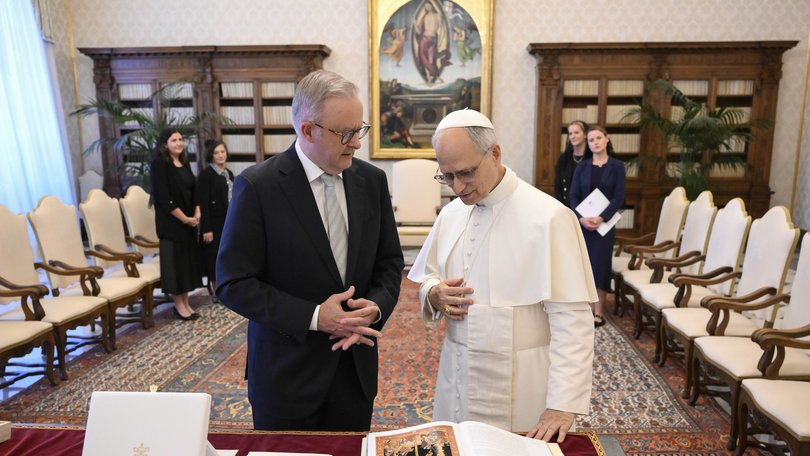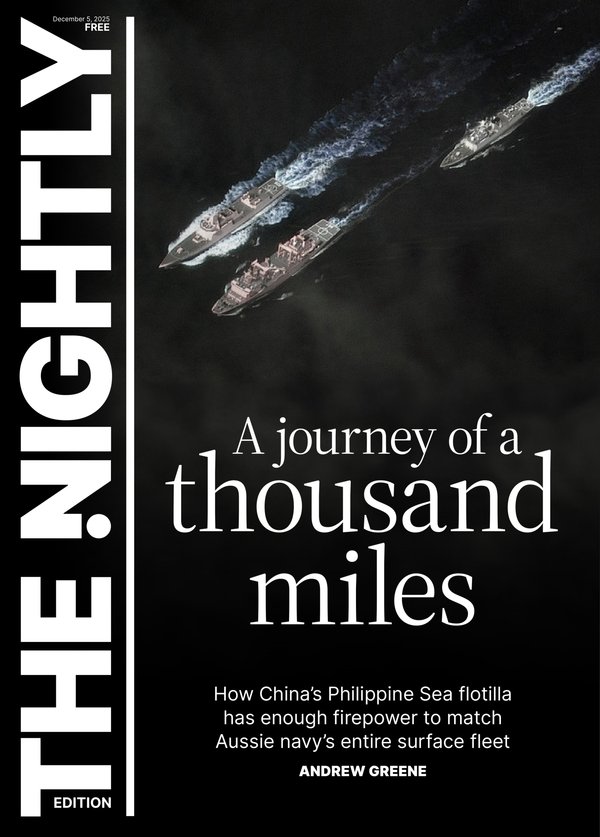LATIKA M BOURKE: Marles expects more US military in Australia amid China tension, but no word on AUKUS
Defence Minister Richard Marles has flagged an increased US military presence in Australia amid growing tensions with China and left the door open to increasing defence spending but has refused to say if taxpayers will be returned the $800 million downpayment on the nuclear submarines if the Trump Administration scraps AUKUS.
Pentagon official and AUKUS-sceptic Elbridge Colby has launched a snap “America First” review into whether the submarine transfer to Australia, scheduled for the 2030s, should take place.
Speaking in an exclusive interview with the Latika Takes podcast in collaboration with The Nightly on the sidelines of the NATO summit, Mr Marles brushed aside his inability to secure a meeting with his US Defence counterpart, Pete Hegseth, at this week’s gathering to discuss whether the program was in jeopardy.
Sign up to The Nightly's newsletters.
Get the first look at the digital newspaper, curated daily stories and breaking headlines delivered to your inbox.
By continuing you agree to our Terms and Privacy Policy.“I’ve got no doubt that I’ll be catching up with him in the not-too-distant future,” he said.
Mr Marles went to NATO in place of Anthony Albanese, who turned down for the second time a special invitation given to leading Indo-Pacific countries, to attend the gathering that brings together the heads of 32 governments including the President of the United States as well as the leaders of other NATO partners, including the head of the European Commission and Ukraine.
Mr Albanese, who attended the Pope’s inaugural mass and had his mother’s rosary beads blessed by the new Pontiff shortly after his landslide election, has not explained why he decided to skip NATO but go to Rome.

With Parliament not sitting, the prime minister kept a light public schedule this week, holding a media conference in Canberra on Monday, appearing on television on Tuesday and attending a 50th anniversary celebration for SBS, as well as visiting a childcare centre in Tasmania.
At NATO, Mr Marles was questioned at a public event about Mr Albanese’s no-show but told those attending that they “shouldn’t read too much” into the Australian Prime Minister’s absence.
Pressed during his later interview with The Nightly, Mr Marles cited the pressures on Mr Albanese in balancing his schedule.
“Leaders can’t do everything in terms of attending meetings that they might otherwise want to,” he said.
“This is going to be, as I said, a meeting which is of increasing importance to us in Australia relative to where we were at, you know, five, 10 years ago.”
The opposition has criticised the Prime Minister for not turning up to the most important NATO summit in decades, after the new Secretary General Mark Rutte’s charm offensive persuaded allies to raise their defence spending to 3.5 per cent of GDP and President Trump to back the group’s collective defence.
The Trump Administration has asked Australia to match NATO’s new standard of 3.5 per cent, but Prime Minister Anthony Albanese and Treasurer Jim Chalmers have shot down the request and said that the current level of around 2 per cent is already a major improvement.
But when asked, Mr Marles appeared to leave the door open to a budget increase for his department and linked any upgrades to the next major Defence Strategic Review, due next year.
“We will continue to go through the process of assessing our strategic circumstances,” he said.

“What comes out of the Defence Strategic Review is a process of iteratively doing that every two years with the National Defence Strategy, and that will occur again next year, and every two years thereafter,” he said.
“We have a process in place to assess what our strategic circumstances are and our needs are, and then to resource them, and as the Prime Minister has said.
“We’ll continue to, you know, respectfully engage in conversations with our allied partners to look at what’s happening in the world.”
Mr Marles could not say if the US would refund the $800 million paid to upgrade US shipyards to help speed up shipbuilding so the sale of between three and five nuclear-propelled Virginia-class submarines can begin in the 2030s.
“We are working on the pathway to getting those production rates up and to having Australia acquire those submarines in the early 2030s; that’s what we’re all seeking to achieve and that’s what I’m confident that we will achieve,” he said.
Increased US military presence in Australia
Mr Marles said it should come as no surprise that the United States will grow its military presence in Australia amid growing tensions with China.
Opposition frontbencher Andrew Hastie has called for a public debate about the expectations and limits that would be put around an increasing US military build-up in Australia.
Earlier this month, Mr Marles said China was “unquestionably . . . at the heart of the complex strategic circumstances” facing Australia and that “our continent” and “geography” was more relevant to great power contest than at any point in history.
This prompted criticism from former Labor prime minister Paul Keating, who described it as a “dark moment” that would expose Australia to military engagement in any conflict between the US and China.
In 2011, the Obama Administration agreed with the Labor government led by Julia Gillard to base US marines out of Darwin.
As part of AUKUS, the United States will start operating its own nuclear-capable submarines out of HMAS Stirling in Perth in 2027.
Mr Hegseth has said in several readouts after speaking to or meeting Mr Marles that they have discussed “accelerating US force posture initiatives in Australia.”
Asked if this meant a greater US military presence in Australia, Mr Marles confirmed it would grow but did not think that would be controversial or surprising.
“We’ve been working since we’ve come to government with the former US Administration and now the current US Administration on US force posture in Australia, and it will grow,” he said.
“It is articulating force posture not just in Stirling, but in really across all the domains, and so there is a growth in that.
“This is not new, this is a journey that we’ve been on over the last few years.
“I think the Australian public do welcome this; it’s important that we are very clear with the Australian public about why.
He said he “very much” thought an increased US presence would make Australia safer.
“What we are seeking to do here is to build capability in Australia, which in turn contributes to balance and stability and ultimately the peace of the regions in which we live; North East Indian Ocean, Northeast Asia, Southeast Asia, the Pacific,” he said.
“That is actually our objective here.
“It is about doing everything we can, of course, to avert conflict, to deter conflict, but to contribute to the peace and stability of the regions in which we live.”
Former Home Affairs boss and author of the 2009 Defence White Paper Mike Pezzullo, recently wrote in the Australian Strategic Policy Institute’s The Strategist, that while the US did not have a significant number of troops in Australia, they were creating the infrastructure for a surge.
“What is being put in place is the infrastructure and enabling services that would be required to support a rapid inwards surge of US personnel and assets at a future time of growing tensions,” he wrote.
“One does not need to have access to the classified plans to see the US is doing this to be able to conduct combat operations against China on a north-south axis from, or through, Australia.”

